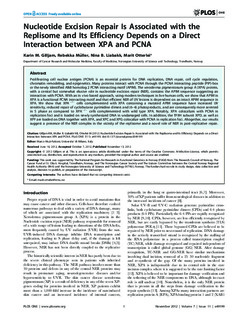| dc.contributor.author | Gilljam, Karin Margaretha | |
| dc.contributor.author | Müller, Rebekka | |
| dc.contributor.author | Liabakk, Nina-Beate | |
| dc.contributor.author | Otterlei, Marit | |
| dc.date.accessioned | 2015-10-30T14:13:03Z | |
| dc.date.accessioned | 2015-11-24T14:02:42Z | |
| dc.date.available | 2015-10-30T14:13:03Z | |
| dc.date.available | 2015-11-24T14:02:42Z | |
| dc.date.issued | 2012 | |
| dc.identifier.citation | PLoS ONE 2012, 7(11) | nb_NO |
| dc.identifier.issn | 1932-6203 | |
| dc.identifier.uri | http://hdl.handle.net/11250/2365523 | |
| dc.description.abstract | Proliferating cell nuclear antigen (PCNA) is an essential protein for DNA replication, DNA repair, cell cycle regulation, chromatin remodeling, and epigenetics. Many proteins interact with PCNA through the PCNA interacting peptide (PIP)-box or the newly identified AlkB homolog 2 PCNA interacting motif (APIM). The xeroderma pigmentosum group A (XPA) protein, with a central but somewhat elusive role in nucleotide excision repair (NER), contains the APIM sequence suggesting an interaction with PCNA. With an in vivo based approach, using modern techniques in live human cells, we show that APIM in XPA is a functional PCNA interacting motif and that efficient NER of UV lesions is dependent on an intact APIM sequence in XPA. We show that XPA−/− cells complemented with XPA containing a mutated APIM sequence have increased UV sensitivity, reduced repair of cyclobutane pyrimidine dimers and (6–4) photoproducts, and are consequently more arrested in S phase as compared to XPA−/− cells complemented with wild type XPA. Notably, XPA colocalizes with PCNA in replication foci and is loaded on newly synthesized DNA in undamaged cells. In addition, the TFIIH subunit XPD, as well as XPF are loaded on DNA together with XPA, and XPC and XPG colocalize with PCNA in replication foci. Altogether, our results suggest a presence of the NER complex in the vicinity of the replisome and a novel role of NER in post-replicative repair. | nb_NO |
| dc.language.iso | eng | nb_NO |
| dc.publisher | Public Library of Science | nb_NO |
| dc.title | Nucleotide excision repair is associated with the replisome and its efficiency depends on a direct interaction between XPA and PCNA | nb_NO |
| dc.type | Journal article | nb_NO |
| dc.type | Peer reviewed | en_GB |
| dc.date.updated | 2015-10-30T14:13:03Z | |
| dc.source.volume | 7 | nb_NO |
| dc.source.journal | PLoS ONE | nb_NO |
| dc.source.issue | 11 | nb_NO |
| dc.identifier.doi | 10.1371/journal.pone.0049199 | |
| dc.identifier.cristin | 988668 | |
| dc.description.localcode | © 2012 Gilljam et al. This is an open-access article distributed under the terms of the Creative Commons Attribution License, which permits unrestricted use, distribution, and reproduction in any medium, provided the original author and source are credited. | nb_NO |
